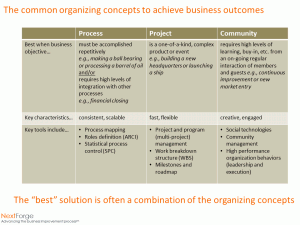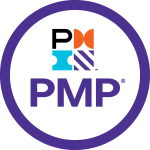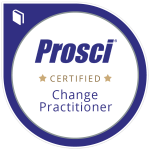“Everything should be made as simple as possible, but no simpler” Albert Einstein
When we talk about execution- achieving some business outcome- each of us has our own bias for how. Some of us think about who we will task with an assignment. Others, particularly if it is a game-changing initiative for our company, will begin to think about the team, the stakeholders and the initiative’s leadership. For this discussion, we are going to focus on the organizing structure which will most effectively achieve business outcomes. Should it be…
We will touch on each common organizing concept in the following sections- the more common approaches to execution necessary to achieve day-to-day work through to transformational business model change.
Process execution
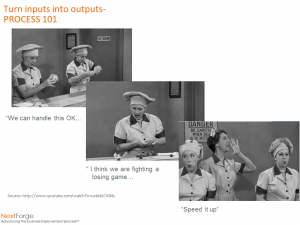 Most of us are familiar with Lucy and Ethel’s efforts at the chocolate factory. And yet this simple 1950’s skit is a real example of a process at its basic level-turning inputs into outputs in an end-to-end process where you can see what needs to be done. Some of the basic process definitions touch on the process customer (can you imagine being Ricky or Fred selling the candies wrapped by Lucy and Ethel?) and there are a number of common tools used to define, for example, responsibilities for process steps. In this 101 level of process, the supervisor measures through observation. There are no real hand-offs, and there is no complex structure.
Most of us are familiar with Lucy and Ethel’s efforts at the chocolate factory. And yet this simple 1950’s skit is a real example of a process at its basic level-turning inputs into outputs in an end-to-end process where you can see what needs to be done. Some of the basic process definitions touch on the process customer (can you imagine being Ricky or Fred selling the candies wrapped by Lucy and Ethel?) and there are a number of common tools used to define, for example, responsibilities for process steps. In this 101 level of process, the supervisor measures through observation. There are no real hand-offs, and there is no complex structure.
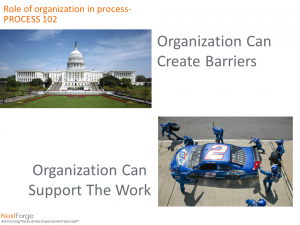 As processes grow in complexity, beyond simple single-task execution and management, the implications of structure begin to become more apparent. We must address the questions of structure to minimize the impact of functional silos and to minimize hand-offs between tasks. In other words, should we create a bureaucratic structure (like US Congress with transient objectives and jobs)? Or, are we better off with a flexible process team (like a NASCAR pit crew with known and inter-changeable roles)? Each end of the continuum involves tradeoffs. Once we have chosen a structure, do we view our process as a complete and insular whole, or should we take a more systemic approach?
As processes grow in complexity, beyond simple single-task execution and management, the implications of structure begin to become more apparent. We must address the questions of structure to minimize the impact of functional silos and to minimize hand-offs between tasks. In other words, should we create a bureaucratic structure (like US Congress with transient objectives and jobs)? Or, are we better off with a flexible process team (like a NASCAR pit crew with known and inter-changeable roles)? Each end of the continuum involves tradeoffs. Once we have chosen a structure, do we view our process as a complete and insular whole, or should we take a more systemic approach?
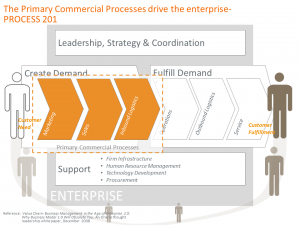 MIT’s Peter Senge introduced systems thinking to the broader audience of business management through his Fifth Discipline series starting in the early 1990’s. While focused on organizational learning, many of Professor Senge’s concepts forced consideration of complex multidimensional mental models, including the then exploding concept of business process reengineering. The confluence of these ways of thinking about processes set up enterprise-level process models which integrated execution activities and became the back-bone for Enterprise Resource Planning programs like SAP and Oracle.
MIT’s Peter Senge introduced systems thinking to the broader audience of business management through his Fifth Discipline series starting in the early 1990’s. While focused on organizational learning, many of Professor Senge’s concepts forced consideration of complex multidimensional mental models, including the then exploding concept of business process reengineering. The confluence of these ways of thinking about processes set up enterprise-level process models which integrated execution activities and became the back-bone for Enterprise Resource Planning programs like SAP and Oracle.
In more recent history, process management has been refined to include detailed measurement schema, waste elimination, learning and feed-back loops popularized, for example, by six sigma and lean. These process approaches can be traced to their development at Toyota Production Systems and their widely publicized implementation at GE.
Project execution
Project management has its origins pre-dating the pyramids. Initially practiced within the construction industry, formalized for aerospace, and adopted by technologists for computer systems development, project and program management is the go-to structure for organizing one-off, unique initiatives and efforts. Although, based on our experience, not deeply understood in the executive suite, “project work” ranks up there with restructuring as a key management tool used to enhance enterprise capabilities. (Note: Interestingly neither project management nor reorganization is listed in Bain’s periodic management tools survey)
We think of project management as the continuous management of the tradeoffs between the work to be accomplished, the time-frame and the resources available/needed. The common thumb-rule for project management is to pick two and define the third- which works within limits (e.g., “Bearing a child takes nine months, no matter how many women are assigned”, Fred Books, The Mythical Man-Month). Program management then provides the platform for managing multiple projects.
Since the mid-1980’s the Project Management Institute (PMI) have created a body of knowledge and certification program expanding from their technology project management roots.
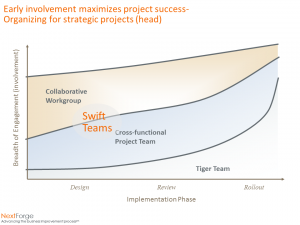 There are a number of approaches to staffing projects and programs to accommodate various real-world constraints. We have briefly profiled four in the following.
There are a number of approaches to staffing projects and programs to accommodate various real-world constraints. We have briefly profiled four in the following.
- Tiger Teams
Pro: Fast to an “answer”; Can be highly confidential
Con: Typically high-risk in roll-out due to limited organizational ownership and understanding - Cross-Functional Teams
Pro: Broader representation and involvement of subject matter experts allows some extended reach into the organization
Con: Slower than Tiger Teams to show initial progress; Requires higher resource commitment- usually locked in for entire project- potentially driving sub-optimal team member selection - Collaborative Workgroup
Pro: Broad participation and ownership from project kickoff accelerates roll-out and enables superior contributions toward a more viable solution
Con: Slower “front end” of project - Swift Teams (A NextForge Hybrid)
Pro: Deliverbles with each short-term interval; Flexible resourcing
Con: Like tiger teams, limited number of staff minimize opportunities to embed solutions into the enterprise
Organizations increase their chances of success through highest amount of engagement as early in implementation as possible. Not only does engagement drive future ownership of the solution, more resources can be brought to bear on perfecting the solution, as represented by the area under the curves. See exhibit, Early involvement…
Community execution
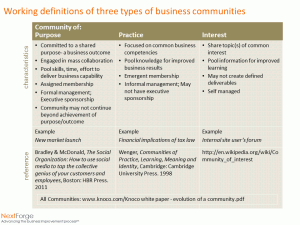 There are as many ways of cutting the concept of community as there are stars in the sky. For simplicity and illustration, we have highlighted three types of communities based on the scope of their objective. We have teased these definitions from multiple sources, as there are no “universally accepted” definitions of community management, particularly as it applies within the enterprise. Community as a way to execute within the enterprise is an innovative management concept facilitated by emerging social platforms providing relatively easy access to people and information.
There are as many ways of cutting the concept of community as there are stars in the sky. For simplicity and illustration, we have highlighted three types of communities based on the scope of their objective. We have teased these definitions from multiple sources, as there are no “universally accepted” definitions of community management, particularly as it applies within the enterprise. Community as a way to execute within the enterprise is an innovative management concept facilitated by emerging social platforms providing relatively easy access to people and information.
The table provides characteristics primarily driven by level of focus on outcome. All promote organizational learning. These illustrative communities include:
- Community of Purpose- directed at organizational objectives and culture
- Community of Practice- supporting group efficiency and competence
- Community of Interest- addressing simple individual effectiveness and knowledge
Communities require attention analogous to a crop. They must be seeded, fed and weeded before they will produce quality outcomes. And, just like crops, yields are highly dependent on their environment (weather).
What is best?
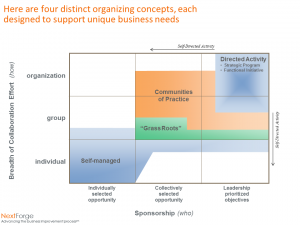 It depends. There is no pure play here, as, for example, projects can be accomplished as part of processes within communities. We advocate for considering Einstein’s admonishment of enough structure, and no more.
It depends. There is no pure play here, as, for example, projects can be accomplished as part of processes within communities. We advocate for considering Einstein’s admonishment of enough structure, and no more.
One holistic guide we developed considers both who is doing the work and who is sponsoring the work. A simple way to consider the categories of each is to think of the individual, a group or the organization (with leadership as a proxy for sponsorship). See exhibit, Here are four…
It is worth repeating- the highest level of engagement of the most stakeholders as early as possible is best to creating a rigorous and embedded business outcome. And, one must consider time and other resource opportunities. This is why we advocate for moving to the more social form- an organizing concept of communities- as much as possible. Over time the applicability of communities will increase as this capability becomes embedded in the organization.

